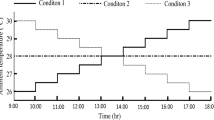Summary
To examine the core-shell model of temperature distribution and the possible role of subcutaneous temperature in heat regulation, comprehensive temperature measurements were made on six nude resting men exposed for 2–3 h to comfort (27° C), cold (15° C) and heat (45° C). Cold produced strong shivering and heat caused heavy sweating. Temperatures were recorded every 10 min from: esophagus, rectum and auditory canal; back muscle and thigh muscle at 20 mm and 40 mm depths; 6 subcutaneous sites; and 16 skin sites. Average temperatures at these 29 sites were tabulated at the ends of comfort, hot and cold and at the onsets of sweating and shivering. Body temperature changes were slow to develop, the skin temperatures being fastest, and successively deeper tissues progressively slower. There was occasional after-drop and after-rise. The data were consistent with the core-shell concept. The temperature gradient from subcutaneous tissue to skin, which differed substantially with comfort, the onset of shivering and the onset of sweating, could serve as a regulatory signal. The data are now in computer format and may be of interest to biothermal modelers.
Similar content being viewed by others
References
Aschoff J, Wever R (1958) Kern und Schale im Wärmehaushalt des Menschen. Naturwissenschaft 45:477–485
Asmussen E, Bøje O (1945) Body temperature and capacity for work. Acta Physiol Scand 10:1–22
Barcroft H, Edholm OG (1946) Temperature and blood flow in the human forearm. J Physiol (Lond) 104:366–376
Bazett HC (1951) Theory of reflex controls to explain regulation of body temperature at rest and during exercise. J Appl Physiol 4:245–262
Carlson LD, Burns HL, Holmes TH, Webb PP (1953) Adaptive changes during exposure to cold. J Appl Physiol 5:672–676
Clarke RSJ, Hellon RF, Lind AR (1958) The duration of sustained contractions of the human forearm at different muscle temperatures. J Physiol (Lond) 143:454–473
Cooper KE, Kenyon JR (1957) A comparison of temperature measured in the rectum, oesophagus, and on the surface of the aorta during hypothermia in man. Br J Surg 44:616–619
Durnin JVGA, Womersley J (1974) Body fat assessed from total body density and its estimation from skinfold thickness: measurements on 481 men and women aged from 16 to 72 years. Br J Nutr 32:77–97
Golden FStC, Hervey GR (1981) The ‘after-drop’ and death after rescue from immersion in cold water. In: Adam JM (ed) Hypothermia ashore and afloat. Aberdeen University Press, Aberdeen, pp 37–56
Hardy JD, DuBois EF (1938) The technique of measuring radiation and convection. J Nutr 15:461–475
Kerslake DMcK (1972) The stress of hot environments. Cambridge University Press, Cambridge
Marcus P (1973) Some effects of heating and cooling areas of the head and neck on body temperature measurements in the ear. Aerosp Med 44:397–402
Molnar GW, Read RC (1974) Studies during open-heart surgery on the special characteristics of rectal temperature. J Appl Physiol 36:333–336
Nielsen B (1969) Thermoregulation in rest and exercise. Acta Physiol Scand [Suppl] 323:1–74
Piironen P (1970) Sinusoidal signals in the analysis of heat transfer in the body. In: Hardy JD, Gagge AP, Stolwijk JAJ (eds) Physiological and behavioral temperature regulation. Thomas, Springfield, pp 358–366
Saltin B, Hermansen L (1966) Esophageal, rectal, and muscle temperature during exercise. J Appl Physiol 21:1757–1762
Shiraki K, Nobuhide K, Sagawa S (1986) Esophageal and tympanic temperature responses to core blood temperature changes during hypothermia. J Appl Physiol 61:98–102
Shiraki S, Sagawa S, Tajima F, Yakota A, Hashimoto M, Brengelman GL (1988) Independence of brain and tympanic temperatures in an unanesthetized human. J Appl Physiol 65:482–486
Webb P (1986) Afterdrop of body temperature during rewarming: an alternative explanation. J Appl Physiol 60:385–390
Webb P, Nagle FJ, Wanta DM (1991) Heat regulation during exercise with controlled cooling. Eur J Appl Physiol 62:193–197
Author information
Authors and Affiliations
Rights and permissions
About this article
Cite this article
Webb, P. Temperatures of skin, subcutaneous tissue, muscle and core in resting men in cold, comfortable and hot conditions. Europ. J. Appl. Physiol. 64, 471–476 (1992). https://doi.org/10.1007/BF00625070
Accepted:
Issue Date:
DOI: https://doi.org/10.1007/BF00625070




